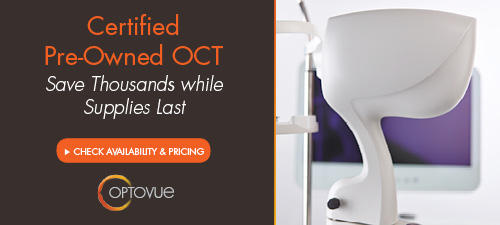
A
weekly e-journal by Art Epstein, OD, FAAO
Off the Cuff: Vision and Invention
This past week I had the pleasure of speaking at Bausch + Lomb’s B+Lieve event in Denver, launching Bausch + Lomb ULTRA® for Astigmatism Contact Lenses. I was tasked with discussing the impact of technology on the ocular surface and how modern contact lenses and materials fit into this complex equation. As I was preparing for the presentation, I ruminated on how much digital device use has changed the way we use our eyes and how quickly this occurred. Keep in mind that the Apple II was launched in 1977 and the IBM PC in 1981. For all the benefits of the personal computer revolution and the explosion of digital devices, we are only now starting to understand some of the unanticipated consequences. Humans are hunter-gatherers. Our eyes are designed to scan the horizon for predators and find food. The advent of digital devices and the endless hours we spend staring at them have fueled an epidemic of “dry eye” and made comfortable contact lens wear far more elusive. As challenging as this can be clinically, the good news is that modern contact lens materials are now being designed to compensate for the altered ocular surface environment of our digital world. It was a treat to have Drs. George Grobe and Dan Hook from B+L join me on the podium to explain the incredible engineering behind the Ultra material. Their innovation bodes well for our patients and will help keep contact lenses a primary form of vision correction for the foreseeable future.
|
|||||

|
||
| Large Disparities in Receipt of Glaucoma Care Between Enrollees in Medicaid and Those with Commercial Health Insurance | ||||
Researchers looked at 21,766 persons ages ≥40 years with newly diagnosed open-angle glaucoma (OAG) between 2007 and 2011 enrolled in Medicaid or a large United States managed care network to determine whether the type of health insurance a patient possessed and/or a patient's race/ethnicity affected receipt of common tests to monitor OAG. Researchers determined the proportion of patients with newly diagnosed OAG who underwent visual field (VF) testing, fundus photography (FP), other ocular imaging (OOI) or none of these tests within the first 15 months after initial OAG diagnosis. Multivariable logistic regression was used to assess the extent by which health insurance type and race/ethnicity affected the odds of undergoing glaucoma testing. A total of 18,372 persons with commercial health insurance and 3,394 Medicaid recipients met the study inclusion criteria. The proportions of persons with commercial health insurance with newly diagnosed OAG who underwent VF, FP and OOI were 63%, 22% and 54%, respectively, whereas the proportions were 35%, 19% and 30%, respectively, for Medicaid recipients. Compared with those with commercial health insurance, Medicaid recipients were 234% more likely to not receive any glaucoma testing in the 15 months after initial diagnosis. After adjustment for confounders, whites with OAG enrolled in Medicaid had 198% higher odds of receiving no glaucoma testing compared with whites possessing commercial health insurance. Blacks with Medicaid insurance demonstrated 291% higher odds of not receiving any glaucoma testing compared with blacks with commercial health insurance. Irrespective of race/ethnicity, researchers determined that Medicaid recipients with OAG received substantially less glaucoma testing compared with persons with commercial health insurance. Disparities in testing were observed across all races/ethnicities but were most notable for blacks. At the same time, researchers wrote, black individuals are more likely than whites to go blind from OAG, and there are disproportionately more blacks in Medicaid. Researchers suggested that efforts were needed to improve the quality of glaucoma care for Medicaid recipients, especially racial minorities. |
||||
SOURCE: Elam AR, Andrews C, Musch DC, et al. Large disparities in receipt of glaucoma care between enrollees in medicaid and those with commercial health insurance. Ophthalmology. 2017; Jun 2. [Epub ahead of print]. |
||||
 |
||
| A Case of Bilateral Corneal Perforation in a Patient with Severe Dry Eye | ||||
Dry eye is a common problem affecting mainly the adult population, and in severe cases, it can result in sterile corneal ulcer and perforation, authors wrote. They reported a rare case of a 26-year-old male, a known patient with severe dry eye who presented with sterile corneal ulcer with corneal perforation in both the eyes. The patient was managed by applying cyanoacrylate glue, and with application of bandage contact lenses in both eyes and topical antibiotic, topical cyclosporine and preservative-free artificial tears at two hourly intervals. The patient was investigated for the systemic cause of severe dry eye, but no cause could be ascertained. On follow up, the patient reported marked relief in photophobia. On examination, both eyes showed sealed perforation with a well-formed anterior chamber. In conclusion, authors wrote that clinicians should examine dry eye patients carefully and detect corneal ulcers and perforations in a timely way to prevent sequelae. |
||||
SOURCE: Deswal J, Arya SK, Raj A, et al. A case of bilateral corneal perforation in a patient with severe dry Eye. J Clin Diagn Res. 2017;11(4):ND01-ND02. |
||||
|
|||
| Decision-making Impairments in Primary Angle-closure Glaucoma Patients | ||||
Primary angle-closure glaucoma (PACG) is a common eye disease and a common cause of blindness, researchers wrote. Inappropriate medical decisions severely affect the prognosis, they added. This study investigated decision-making under risk in PACG patients. Thirty patients with a first acute attack of PACG before surgery, and thirty healthy controls were included. Decision-making under risk was evaluated with the game of dice task (GDT). Results of the Eysenck Personality Questionnaire (EPQ) and GDT between PACG patients and healthy controls were compared. Risky decisions in PACG patients were made more often than in healthy controls as measured by a mean score of GDT (12.47 ±5.72 vs. 4.33 ±3.30). A higher neuroticism score in EPQ was found in PACG patients compared with healthy controls (14.97 ±3.93 vs. 9.90 ±4.49). Neuroticism scores in EPQ were associated with decision-making performance (r=0.417). Investigators found that neuroticism positively correlated with risky decisions, and suggested that decision-making might be influenced by neuroticism. Future studies will show whether therapy compliance will be improved by emotional management and psychological intervention in PACG patients. |
||||
SOURCE: Pu H, Wang Y, Wei Q, et al. Decision-making impairments in primary angle-closure glaucoma patients. Chin Med J (Engl). 2017;130(12):1424-1428. |
||||

|
||
| News & Notes | |||||||||
| Dr. Talamo Joins Johnson & Johnson Vision as CMO Johnson & Johnson Vision Care announced that, in July, Dr. Jonathan Talamo will begin serving as chief medical officer and worldwide vice president of medical affairs and clinical affairs for Johnson & Johnson Vision, which includes its Vision Care and Surgical businesses. Dr. Talamo joins from Ocular Therapeutix, where he served as CMO. Prior to that, he owned a private medical practice for almost 20 years, specializing in refractive surgery, cataract surgery and corneal transplantation. Dr. Talamo has authored more than 80 original peer-reviewed publications, review articles and book chapters, and given lectures worldwide on topics related to corneal disease, cataract and refractive surgery. He is a recipient of Honor and Senior Achievement awards from the American Academy of Ophthalmology. Read more.
|
|||||||||
| Dr. Massimo Fazio receives 2017 Xtreme Research Award Massimo Fazio, PhD, a biomechanics and mechanobiology researcher at the Department of Ophthalmology in the University of Alabama at Birmingham, received the award at an event held by Heidelberg Engineering during ARVO’s Annual Meeting in Baltimore. Dr. Fazio has a background in mechanical engineering, and his work focuses on developing advanced image processing algorithms and custom optical devices to investigate the biomechanics and morphology of ocular tissue in glaucoma and myopia. Although still in its early stages, Dr. Fazio’s research aims to develop imaging methods that can enhance optical coherence tomography-based diagnostic parameters and offer customized analyses that may be predictive of future damage. Read more. |
|||||||||
| AOF Announces Award of Excellence in CL Patient Care Recipients The American Academy of Optometry Foundation revealed the 2017 Johnson & Johnson Vision Award of Excellence in Contact Lens Patient Care program recipients. This award recognizes outstanding fourth-year student clinicians who have demonstrated excellent overall knowledge of the contact lens field plus skillful, considerate and professional care of contact lens patients during their optometric education. Each winner receives a $500 educational award and a personalized plaque commemorating their accomplishment. Read more. |
|||||||||
| Dr. Johnson Appointed Paragon Director of Clinical Services Paragon Vision Sciences appointed Leah Johnson, OD, FAAO, as director, clinical services. Prior to joining, Dr. Johnson was in private practice at Vision Optique in Houston. She is a graduate of the University of Houston College of Optometry, where she completed her post-doctorate work in cornea and contact lenses. Dr. Johnson’s published work includes research in specialty contact lenses. Read more. |
|||||||||
| IDOC Wins Gold Hermes Creative Award IDOC, one of the largest privately held alliance of independent optometrists in the United States, won a Gold Hermes Award in the Magazine / Newsletter category for IDOC’s magazine The Quarterly magazine. The Hermes Creative Awards are an international competition that honors creativity and excellence in new media. Read more. |
|||||||||
|
Optometric Physician™ (OP) newsletter is owned and published by Dr. Arthur Epstein. It is distributed by the Review Group, a Division of Jobson Medical Information LLC (JMI), 11 Campus Boulevard, Newtown Square, PA 19073. HOW TO ADVERTISE |



